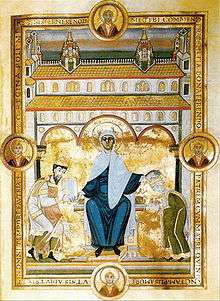Golden Gospels of Henry III

The Golden Gospels of Henry III, also Codex Aureus of Speyer or Speyer Gospels (Speyerer Evangeliar), (El Escorial, Real Biblioteca, Cod. Vitrinas 17) is an eleventh-century illuminated Gospel Book. The manuscript contains the Vulgate versions of the four gospels plus prefatory matter including the Eusebian canon tables. It was probably produced at the Abbey of Echternach under the patronage of Henry III, Holy Roman Emperor. In 1046, Henry donated the manuscript to Speyer Cathedral to commemorate the dedication of the cathedral's high altar. The manuscript has 171 folios which measure 500mm by 335mm and is lavishly illuminated. It contains 13 full page miniatures, and 43 half-page miniatures, 12 decorated pages of canon tables, and over 40 other decorated pages half-page initials.
The manuscript was later owned by Maximilian I. It was later in the Netherlands where it was owned by Maximilian's daughter Margaret and Maximilian's granddaughter Mary. While in the Netherlands the manuscript was used by Erasmus. The manuscript was then owned by Philip II, King of Spain, who donated it to the monastery at El Escorial.
See also
References
- Walther, Ingo F. and Norbert Wolf. Codices Illustres: The world's most famous illuminated manuscripts, 400 to 1600. Köln, TASCHEN, 2005.
Further Reading
- Dodwell, C.R. The Pictorial Arts of the West, 800-1200. New Haven: Yale University Press, 1993.